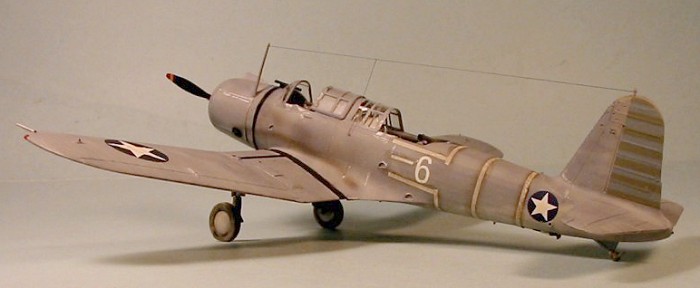
Accurate Miniatures 1/48 SB2U-3 Vindicator
| KIT #: | ? |
| PRICE: | $37.95 MSRP |
| DECALS: | about 4-5 options |
| REVIEWER: | Tom Cleaver |
| NOTES: |

| HISTORY |
The SB2U-1 and SB2U-2 was the first monoplane dive bomber accepted into service by the U.S. Navy. From the beginning, the airplane was not a success as a dive bomber, since Vought was unable to come up with a way of braking the airplane’s speed in a 70-degree dive. The tactic of extending the landing gear did not sufficiently slow the airplane. The Northrop BT-1 - with its perforated dive flaps that allowed speed to be kept to under 270 knots in a dive, which allowed the pilot to accurately aim the airplane at the target - showed much more potential, and was ultimately to appear as the SBD Dauntless, the best dive bomber of the Second World War.
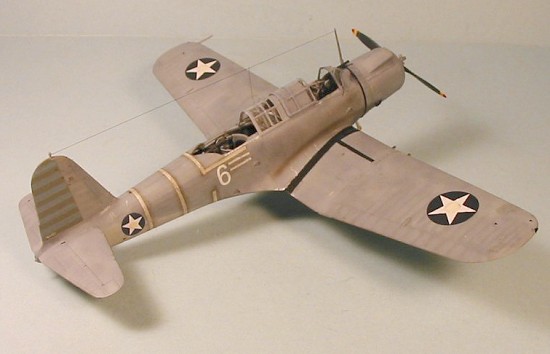 Nevertheless, in 1940 Vought proposed a “long range” scout/dive bomber
development of the design with increased armament and armor, which the Navy
accepted as the SB2U-3. Originally developed as a floatplane, the
performance of the XSB2U-3 on floats was so poor that the concept was
abandoned and the 57 SB2U-3s ordered were produced as land planes and
handed over to the Marines, since the Navy didn’t want them. The SB2U-3,
which had the same powerplant as the earlier airplanes, with additional
weight from four 50 caliber guns in the wings and increased fuel supply,
had an even poorer performance than its forebears. VMSB-1 and VMSB-2 were
equipped with airplane, now known as the “Vindicator” in the summer of
1941.
Nevertheless, in 1940 Vought proposed a “long range” scout/dive bomber
development of the design with increased armament and armor, which the Navy
accepted as the SB2U-3. Originally developed as a floatplane, the
performance of the XSB2U-3 on floats was so poor that the concept was
abandoned and the 57 SB2U-3s ordered were produced as land planes and
handed over to the Marines, since the Navy didn’t want them. The SB2U-3,
which had the same powerplant as the earlier airplanes, with additional
weight from four 50 caliber guns in the wings and increased fuel supply,
had an even poorer performance than its forebears. VMSB-1 and VMSB-2 were
equipped with airplane, now known as the “Vindicator” in the summer of
1941.
The Vindicator at Midway:
VMSB-1, the “east coast” Marine Scout-Dive Bomber unit, was renumbered VMSB-231 in October 1941 and sent to the west coast as war clouds gathered in the Pacific. In November, the unit was sent on to MCAS Ewa at Pearl Harbor. During the first week of December, 18 of the unit’s 24 Vindicators were loaded aboard the “Saratoga”, for shipment on to Midway. Following the attack on Pearl Harbor, which happened before “Saratoga” could send the Vindicators on to Midway Island, the carrier was recalled to Pearl Harbor, where the Marines found the Vindicators left behind at Ewa had been destroyed in the Japanese attack. On December 23, 1941, 18 SB2U-3s, accompanied by a PBY for navigation, demonstrated their long-range capability when they made the 1,135 mile flight from Oahu to Midway in 9 hours and 45 minutes. At Midway, the squadron joined the F2A-3s of VMF-221 as Marine Air Group 22, the westernmost American unit in the Pacific, following the surrender of Wake Island the week before.
Discovered in 1859 and annexed by the United States in August 1867, Midway Atoll consists of Sand and Eastern islands, surrounded by a coral reef less than six miles in diameter. The atoll was used as a cable station and airport for Pan American Airways’ China Clipper until March 1941, when the U.S. Navy began construction of a naval air station. Completed in August 1941, Midway NAS included a 5,300-foot runway on Eastern Island. Midway entered the war on December 7 when the Japanese destroyers Sazanami and Ushio shelled the airfield. With the outbreak of war, Midway became vitally important, though at the time none of its personnel could have imagined how important.
Marine 2nd Lt. Sumner H. Whitten had been at Pearl Harbor for the Japanese attack. In late December, he and 14 of his fellow brand-new Marine aviators were assigned to MAG-22 at Midway - seven to VMF-221 and seven to VMSB-231. They shipped out for Midway the first week of January 1942 on the only troop-carrying destroyer the Navy had.
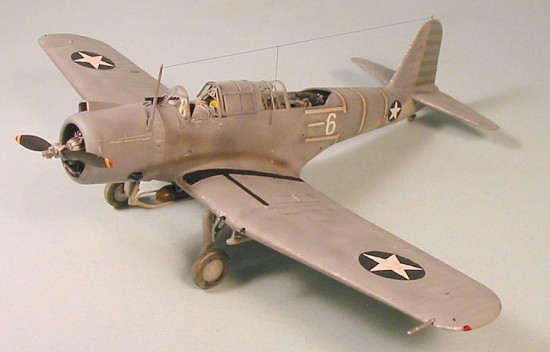 Whitten later remembered that “The SB2U-3 was a slow plane, as far as speed
went, and a lousy bomber. They didn’t know much about dive brakes when they
built the SB2U-1 and 2. Up until then, dive bombers had been biplanes, and
they produced enough drag to keep down the speed in a dive, but with a
cleaned-up monoplane like the SB2U series, you’d easily see 390-400 knots
on your airspeed meter in a dive from 8,000 feet. It was like riding a
rock! You could hardly maneuver - the ailerons became stiff as a board. We
would drop our landing gear, which slowed us down a bit - 15 to 20 knots -
but you still had to be very strong to operate an SB2U in a dive.”
Whitten later remembered that “The SB2U-3 was a slow plane, as far as speed
went, and a lousy bomber. They didn’t know much about dive brakes when they
built the SB2U-1 and 2. Up until then, dive bombers had been biplanes, and
they produced enough drag to keep down the speed in a dive, but with a
cleaned-up monoplane like the SB2U series, you’d easily see 390-400 knots
on your airspeed meter in a dive from 8,000 feet. It was like riding a
rock! You could hardly maneuver - the ailerons became stiff as a board. We
would drop our landing gear, which slowed us down a bit - 15 to 20 knots -
but you still had to be very strong to operate an SB2U in a dive.”
On Midway, Whitten was assigned Aircraft BuNo. 2054, number 11 in the squadron. As he recalled, “My crewman was Sergeant Frank E. Zelnis. Me being from outside Boston, and he from a very recently immigrated Latvian family, we could hardly understand each other, but finally - a couple of weeks later - we could interpret each other over the intercom. Frank was a good ordnance man who taught me about the guns on the plane. He cleaned his own gun, while my job was to clean the fixed .50s. I was also responsible for cleaning inside the cockpit, as well as the brakes and wheels, including the tail wheel. Keeping the brakes clean was important because the coral dust we kicked up during takeoff and landing wore out the brakes in no time.”
At the time of their departure for Midway, the SB2U-3s of VMSB-231 were due for an overhaul that would have included replacing the wing and fuselage fabric. Suffering from heat, sunlight, and salt air on Midway, the fuselage fabric went from bad to worse, and the squadron was reduced to wrapping 4-inch medical tape over the worst areas to keep the fabric in place, which was then doped over, resulting in all the dirt on the airplane at the moment being preserved. under the dope. These were the famous “white stripes” seen in photos. No two airplanes had similar taping.
Through the first five months of 1942, the Vindicators would take off at 0400 for a morning anti-submarine patrol, with an evening patrol taking off at 1730. As Whitten recalled, “In between, we’d practice bombing during the day. There was a barge out in the lagoon, but we got no practice in hitting a moving ship. Meanwhile, Japanese submarines were watching us - they knew what we had. Every Friday night the Japanese shelled us, but the three or four rounds they fired were not too effective considering that the island was no more than 4 feet above sea level. We’d sit on top of our dugout on Friday night, wondering where the shells would come from and where they would go. Most went right over the island and into the lagoon. They sometimes hit, making a hole 15 feet long, and we’d just fill it in.”
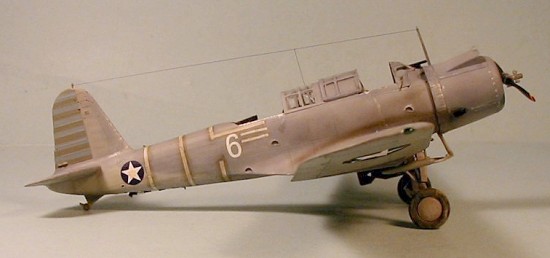 In February 1942, several of VMSB-231 personnel were sent back to MCAS Ewa
to form new squadrons, and on March 1, 1942, the squadron was redesignated
VMSB-241, the “Sons of Satan.”
In February 1942, several of VMSB-231 personnel were sent back to MCAS Ewa
to form new squadrons, and on March 1, 1942, the squadron was redesignated
VMSB-241, the “Sons of Satan.”
At the end of May., 1942, the pilots were informed the war was coming to them, with the main Japanese fleet set to hit Midway and invade it within a week. The squadron received 16 SBD-1 and SBD-2 airplanes a day later, to supplement the tired old SB2U-3sw
On June 4, 1942, the squadron was ordered to take off at 0700 and attack the Japanese fleet. As Whitten remembered, “Major Benjamin W. Norris led 12 SB2Us, though one had to drop out with mechanical problems. Japanese carrier planes were attacking Midway - when we were taking off, bombs were falling on the island. All aircraft of the squadron were to rendezvous 40 miles east of the island, but when our SB2Us got there the SBDs were long gone, so we climbed at 200-300 feet per minute until we reached 8,000 feet, just above the clouds.”
“The weather over Midway on June 4 was clear, with scattered clouds. However, as we proceeded northwest toward the Japanese fleet the cloud cover became more complete. By the time we were within 25 miles of the projected attack point, the cloud cover was solid to broken, heavy clouds, extending up to 8,000 feet. We could see - between breaks in the overcast - elements of the Japanese fleet. I can remember seeing a carrier going on a course of say 120 degrees, with flames coming out of it and a destroyer alongside, along with a couple of other wakes. Then, suddenly, we came under attack. Zelnis said three Zero fighters came at him, joined after two or three runs by more.”
The SB2U-3s were in three four-plane sections, in a step-down formation. Whitten recalled that as the Japanese Combat Air Patrol came in, “Zelnis was a damn good gunner, and I was greatly relieved by that. He was firing almost continuously, in two to three-round bursts so as not to waste the 90 rounds in his drum, which he would then have to change. You had to be awfully adept at doing this in a slipstream, with fighters firing at you. During the fight, a Zero went under my right wing with black smoke pouring from the junction of the engine and fuselage and wing. That is probably the one with which he was officially credited. Another Zero came down at a 90-degree angle, burning back down the whole fuselage. I personally believe that Zelnis should have been credited with two kills, but for a gunner, one is more than normal, and we lost several gunners before we got to the fleet.”
Over the Japanese fleet, the Vindicators dove down in column formation through cloud breaks, still under attack by Zeros. the emerged into clear air at about 3,500-4,000 feet, in the vicinity of a battleship, which Norris ordered them to attack, since going after the carriers would have meant flying across the entire fleet while under attack.
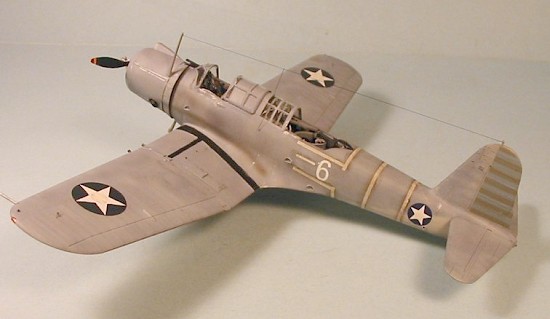 Whitten remembered, “I made a lousy attack-from 4,000 feet, I could not get
a good approach. Making too shallow a dive, diagonally from starboard aft
to forward port, I dropped my bomb off the bow of the ship, but didn’t hit
it. But we scared ’em. Major Norris, 2nd Lt. George T. Lumpkin and 2nd Lt.
Kenneth O. Campion dived on the battleship, too. Norris managed to score a
near miss that caused it some damage. I think there was a direct hit made
amidships... I then made a sharp right turn and started home at 100 feet.
We made it back okay - ours was the only plane in the squadron that was not
damaged during the battle.”
Whitten remembered, “I made a lousy attack-from 4,000 feet, I could not get
a good approach. Making too shallow a dive, diagonally from starboard aft
to forward port, I dropped my bomb off the bow of the ship, but didn’t hit
it. But we scared ’em. Major Norris, 2nd Lt. George T. Lumpkin and 2nd Lt.
Kenneth O. Campion dived on the battleship, too. Norris managed to score a
near miss that caused it some damage. I think there was a direct hit made
amidships... I then made a sharp right turn and started home at 100 feet.
We made it back okay - ours was the only plane in the squadron that was not
damaged during the battle.”
Two SB2Us, crewed by Lt. Andrew Campion and Private Anthony J. Maday and 2nd Lt. James H. Marmande and Pfc Edby M. Colvin, failed to return. Second Lieutenant Allan H. Ringblom ran out of fuel, and had to ditch. He and his gunner, Private E.L. Webb, were rescued by PT-26. Lt. Cummings also had to ditch a few miles short of Midway, and was rescued by PT-20.
The survivors of the morning strike were refueled and rearmed. They spent until 1900 waiting to go out, at which time they were ordered to find and attack two burning Japanese carriers.
The SBDs, now led by Captain Marshall A. Tyler, following the death of squadron CO Major Henderson in the morning attack, went out on their own. Major Norris led five SB2U-3s in a V formation. Whitten was at the extreme left of the formation. As he remembered, “The weather was bad, and we never found a target. It became dark - Williamson’s lighted compass and the flames from his exhaust stacks were the only lights I could see. We zigzagged around some clouds, and suddenly nobody was there - the others must have gone on. I made a square search for two minutes, then said to myself, ‘I’m going home.’” After another 15 minutes, he jettisoned his 500 pound bomb. “After another square search, I found Pearl and Hermes, a coral outcropping southeast of Midway, so I knew where I was. I turned around and headed for Midway, but Midway didn’t turn up. I did a two-minute square search, then another for four minutes, then turned back. Then Zelnis told me, ‘Make a 180-I see flames.’I didn’t see anything, but I turned in that direction for a minute or so, and then I saw the fire - an oil tank that the attacking Japanese planes had hit on Sand Island.” Whitten was fired on by the Marine defenders as he entered the landing pattern, but #11 was still lucky and wasn’t hit. “After I landed, they took a half a pail of fuel out of my tanks. Major Norris’ plane never came back, but everyone else did. By the time I’d finished my debriefing, it was about 2 or 2:30 in the morning.”
The next morning, Whitten was allowed to sleep in, since the squadron had more crews than planes. At 0430, VMSB-231 took off to attack two enemy cruisers. 2nd Lt. Robert W. Vaupell flew Whitten’s airplane. “Tyler’s six SBDs failed to finish Mogami, but our six SB2Us, led by Captain Fleming, got a couple of hits on Mikuma - one got a solid hit forward of the ship, and another got a bouncer off the back end. Dick Fleming’s SB2U was hit by anti-aircraft fire early in the attack and burst into flames, but he flew his plane into the ship, killing himself and his gunner, Pfc George A. Toms. The executive officer of Mikuma, who survived the battle, said he thought Fleming was a very brave man because he hit the after turret and put it out of action. He also caused a fire that was sucked into Mikuma’s starboard air intakes, suffocating her engineers.”
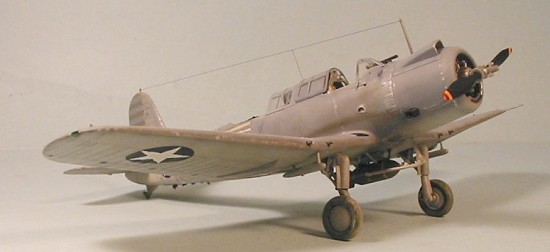 Recalling the missions at Midway, Whitten said, “We did what we could with
what we had. I’d like to add, though, that I have always admired the guts
of those rear-seat gunners. Especially those in the Vindicators who had to
change ammo cans in the face of enemy attacks. Those kids - and most of
them were kids - were a trusting lot. They rode along backwards, most of
the time, not having a say about where or why or how or when. They died
when their pilots died, far too many times. And their recognition has never
equaled their devotion to duty.”
Recalling the missions at Midway, Whitten said, “We did what we could with
what we had. I’d like to add, though, that I have always admired the guts
of those rear-seat gunners. Especially those in the Vindicators who had to
change ammo cans in the face of enemy attacks. Those kids - and most of
them were kids - were a trusting lot. They rode along backwards, most of
the time, not having a say about where or why or how or when. They died
when their pilots died, far too many times. And their recognition has never
equaled their devotion to duty.”
Whitten was sent back to Pearl Harbor that September to become Executive Officer of an SBD squadron that arrived on Guadalcanal in December, where they fought through the Solomons Campaign until August 1943, when he returned to the United States to work on the development of the system of Forward Air Controllers the Marines would use with such devastating effect in the Marianas, at Iwo Jima, and Okinawa.
VMSB-231 remained on Midway until September 1943, when they returned to Pearl Harbor. Among the aircraft they left behind were three surviving SB2U-3s, by that time they were the last Vindicators being used by any American unit anywhere.
| THE KIT |
Please visit the preview for a report on what’s in the box.
| CONSTRUCTION |
The main point of difference between construction of this kit and construction of the SB2U-1 kit previously reviewed was an attempt to deal with the problem of the fuselage sink areas in a different manner.
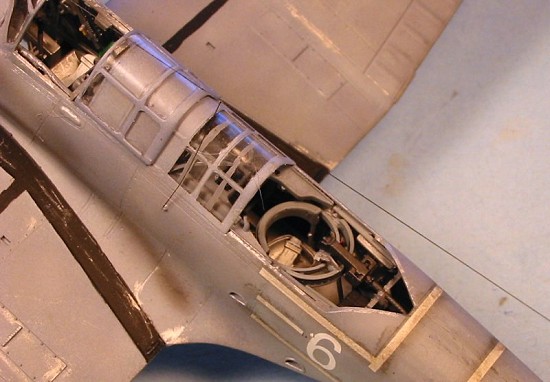 This kit differed from the SB2U-1 in that the sink area was particularly
prominent over the rearmost internal bracing, resulting in a sink mark that
ran clear around both fuselage halves at approximately just ahead of the
halfway point between the rear cockpit and the vertical fin. This time, I
ran cyanoacrylate glue around it , spreading it smooth to either side of
the sink, and allowing it to cure naturally without use of zip kicker. I
had to apply a second coat to get the sink area completely filled. I then
scraped it smooth facet-by-facet, with a #11 Xacto blade, then smoothed it
with a flat-face rat-tail file and then sanded smooth with fine-grit
wet-r-dry. I then polished the area to make it as smooth as the rest of
the fuselage part. The sink area was still slightly noticeable when held
up to the light, but fortunately it was right at the point where there is a
full wraparound tape on the airplane I was going to model, so I knew I
could cover it successfully.
This kit differed from the SB2U-1 in that the sink area was particularly
prominent over the rearmost internal bracing, resulting in a sink mark that
ran clear around both fuselage halves at approximately just ahead of the
halfway point between the rear cockpit and the vertical fin. This time, I
ran cyanoacrylate glue around it , spreading it smooth to either side of
the sink, and allowing it to cure naturally without use of zip kicker. I
had to apply a second coat to get the sink area completely filled. I then
scraped it smooth facet-by-facet, with a #11 Xacto blade, then smoothed it
with a flat-face rat-tail file and then sanded smooth with fine-grit
wet-r-dry. I then polished the area to make it as smooth as the rest of
the fuselage part. The sink area was still slightly noticeable when held
up to the light, but fortunately it was right at the point where there is a
full wraparound tape on the airplane I was going to model, so I knew I
could cover it successfully.
I painted the cockpit aluminum, and then painted the upper rear deck and the turret ring light blue-grey. This is the way the SB2U-2 at the Pensacola Museum is painted, and I suspected the same method might have been used on the SB2U-3s when they were fully camouflaged.
The canopies are too thick to get the rear canopy completely inside the main canopy and still leave room for the rear cone. Instead, I slipped the rear canopy inside before attaching the main canopy and saw where its canopy frames would be seen if it was fully under the main canopy. I then painted these on to the inside of the main canopy. I was then able to put the cone completely inside in its proper location. The famous photo of Vindicator #6 shows the rear canopy was fully-stowed. Doing this looks fine in 1/48 if you do not have the Falcon vacuform canopy available, which can be completely mounted correctly.
| COLORS & MARKINGS |
Painting:
Once the model is constructed, the big part of the work is still ahead for a modeler who wants to do one of the VMSB-241 Vindicators at Midway. As related by Sumner Whitten, the conditions at Midway were primitive, with the airplanes subject to sun, high humidity and saltwater air, without benefit of being hangared at any time from their arrival at Midway until the battle in June. These conditions are death on paint, and what few photos of these airplanes survive show the paint badly weathered and sun-faded.
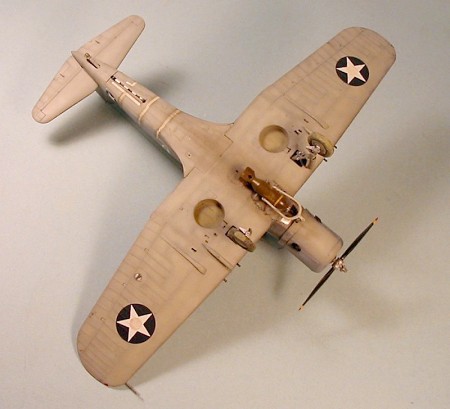 When the SB2U-3s were originally delivered in 1941, they were in a
factory-applied scheme of overall Non-Specular Light Grey. Some people
think this color is the modern Light Gull Grey, while others think it is
something closer to the pre-war Navy color of “Aircraft Grey” which had
been used on the metal surfaces of Navy airplanes like the F4B-4 prior to
the adoption of aluminum lacquer on metal surfaces. I spent an afternoon
watching “Dive Bomber” in glorious Technicolor, freeze-framing all the
shots of overall-grey airplanes, and I think the color is something close
to Light Gull Grey. what I ended up using was Tamiya “Sky Grey” as a base
color, then applying Gunze-Sangyo “Light Gull Grey” over that,
progressively lightened with white to give a multi-hue color. This was
applied over the entire model.
When the SB2U-3s were originally delivered in 1941, they were in a
factory-applied scheme of overall Non-Specular Light Grey. Some people
think this color is the modern Light Gull Grey, while others think it is
something closer to the pre-war Navy color of “Aircraft Grey” which had
been used on the metal surfaces of Navy airplanes like the F4B-4 prior to
the adoption of aluminum lacquer on metal surfaces. I spent an afternoon
watching “Dive Bomber” in glorious Technicolor, freeze-framing all the
shots of overall-grey airplanes, and I think the color is something close
to Light Gull Grey. what I ended up using was Tamiya “Sky Grey” as a base
color, then applying Gunze-Sangyo “Light Gull Grey” over that,
progressively lightened with white to give a multi-hue color. This was
applied over the entire model.
The Vindicators were given a field-applied camouflage of Blue-Grey over the upper surfaces. The Navy SB2U-1s and -2s were camouflaged with this color on the lower surfaces of the folding wings, as camouflage when the airplanes had their wings folded aboard a carrier (which is why the Corsair has a similar camouflage). However, the Marine SB2U-3s were never going to be used from carriers operationally. From looking at the few pictures of VMSB-241 SB2U-3s, I think the Blue Grey camouflage was only applied to the upper surfaces, and not to the outer lower surfaces of the wings. This is the result of a lot of staring at pictures and comparing tonal values, as well as looking at the color footage taken by John Ford at Midway, where the color of the lower surface appears lighter than the very-faded upper surface. This could be wrong, but it is “in character” with a field-applied camouflage at a period when the rules of what to paint were not entirely clear.
Painting the upper surface started with a very thin coat of Gunze-Sangyo “Blue Grey,” applied so there were “holidays” in the paint over the metal areas of the airframe, since it is reported that these areas showed a lot of grey. This would be the case for field-applied paint wearing off over a proper factory-applied paint in the conditions the airplanes experienced.
I then applied Xtracrylix “Blue Grey” to the fabric areas, and also used it to go over the metal areas, to start fading the darker Gunze-Sangyo color. I then applied a little light grey to this paint, and went over the surfaces again, fading them in patches. This was followed with an addition of white to the paint, and I went over the model again. When the paint looked sufficiently ravaged by sun, humidity and salt air, I set the model aside to dry overnight. When all was dry, I gave the model an overall coat of Xtracrylix Gloss varnish.
Hopefully the reader will be able to see this “patchy” effect in the photos.
Decals:
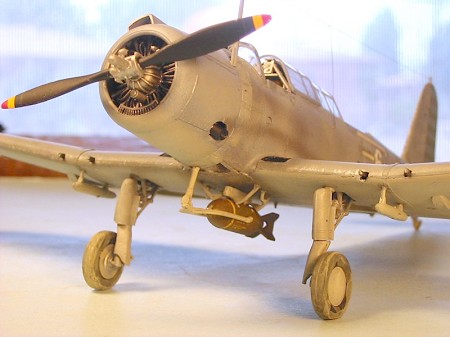 The first thing I did was apply the medical tape, using some white stripe
decals that were the proper scale 4-inch width. I decided to do Vindicator
#6, the airplane flown by 2nd Lt. James H. Marmande and Pfc Edby M. Colvin,
which is so well-known from it having been photographed by John Ford, with
the photo now being iconic of the Marine SB2Us at Midway. Unfortunately,
there are no photos of the left side of the airplane, so I guessed at what
would be the areas in need of taping. When these decals had set, I
airbrushed them with Tamiya “Smoke”, since the photos show a dark area
around all the tape, where they were doped over dirty surfaces. This took
care of camouflaging the area of the fuselage sink marks.
The first thing I did was apply the medical tape, using some white stripe
decals that were the proper scale 4-inch width. I decided to do Vindicator
#6, the airplane flown by 2nd Lt. James H. Marmande and Pfc Edby M. Colvin,
which is so well-known from it having been photographed by John Ford, with
the photo now being iconic of the Marine SB2Us at Midway. Unfortunately,
there are no photos of the left side of the airplane, so I guessed at what
would be the areas in need of taping. When these decals had set, I
airbrushed them with Tamiya “Smoke”, since the photos show a dark area
around all the tape, where they were doped over dirty surfaces. This took
care of camouflaging the area of the fuselage sink marks.
Unfortunately, the wing national insignia supplied in the kit is incorrect. The kit-supplied roundels are the 60-inch insignia used pre-war by the SB2U-1/2s, which was kept on those airplanes when they were camouflaged in 1941. Photos of the SB2U-3s show them with a smaller insignia in their overall-grey camouflage. I suspected that the Marines had not painted larger insignias when they applied the upper right and lower left insignias in early 1942, though I wasn’t sure what size these markings were. Fortunately, Wayne Tevlin - “Mr. Yellow Wings” - came through with the information that the SB2U-3 used 40" roundels on the wings. I used 4 of the 40-inch roundels supplied on the Yellow Wings Decals sheet of pre-war insignia.
The above information isn’t a criticism of Accurate Miniatures. The photographic information available about these Midway airplanes is not very good, and using the existing SB2U-2 at the Pensacola Museum is not a bad idea in face of the lack of other information. But if you want to do your Midway SB2U-3 right, get hold of four 40-inch roundels for the wings.
I painted out the red centers of the markings, using thinned white paint so the center would show through a bit as is seen on the photos of these airplanes. I think this looks more accurate than using the white circles over the red circles, not to mention those are too big for the correct wing insignia.
Other than that, I used the kit decals for the rest of the markings. All of the serials are provided for the VMSB-241 Vindicators, so a modeler can do every one of them if you want. I would have done Sumner Whitten’s airplane, but I managed to drip water on the decal sheet and ruin one of the “1" decals supplied, so I couldn’t do his #11.
| FINAL CONSTRUCTION |
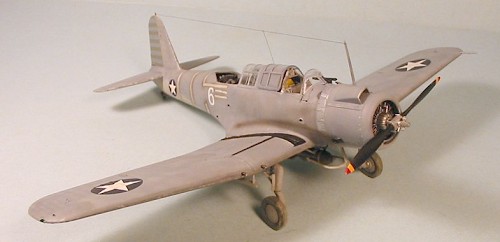 When the decals had set up, I airbrushed Tamiya “Smoke” for the exhaust and
“dinged” the airframe with aluminum paint applied with a 0000 brush. I
then gave the model a coat of Xtracrylix Satin Varnish, followed by a coat
of Xtracrylix Flat varnish. When this was dry, I applied three coats of
thinned Dullcote to get a dead-flat finish to the model.
When the decals had set up, I airbrushed Tamiya “Smoke” for the exhaust and
“dinged” the airframe with aluminum paint applied with a 0000 brush. I
then gave the model a coat of Xtracrylix Satin Varnish, followed by a coat
of Xtracrylix Flat varnish. When this was dry, I applied three coats of
thinned Dullcote to get a dead-flat finish to the model.
Sumner Whitten made a point in his interview of the fact that the Vindicators at Midway carried 500-pound bombs. This was due to the fact there were no 1,000-pounders on the island. However, given the poor performance of the airplane under a full load, the Marines had decided back when they first received the SB2U-3 to limit its load to 500 pounds. I used a 500-pounder left over from an Accurate Miniatures B-25to arm the model.
| CONCLUSIONS |
For those who have managed to get their knickers in a knot over this kit, I hope you all see that a good model can be made, even when it is a kit that has the bad sink marks. It appears that - in time - Accurate Miniatures will be able to obtain replacement sprues for the bad shots, and perhaps later this fall those who don’t want to deal with the sink marks will be able to get replacement parts. However, I have had e-mail from several modelers who report that dealing with the problem was no more difficult than I have reported here. “Some modeling skill required” seems to be the solution to the problem. I do think that using cyanoacrylate glue works better than using Mr. Surfacer 500, as I used on the previous kit.
The SB2U-3 when finished is a fitting memorial to a group of brave men who, as Sumner Whitten said, “did what we could with what we had.”
August 2005
Copyright ModelingMadness.com
Review kit courtesy of my wallet.
If you would like your product reviewed fairly and fairly quickly, please contact the editor or see other details in the Note to Contributors.